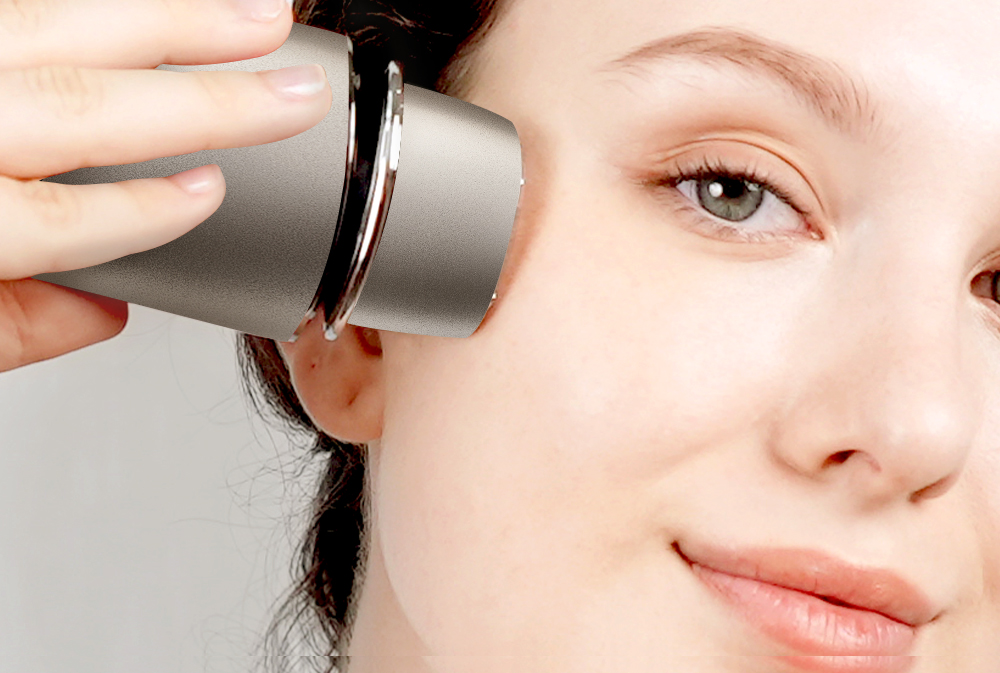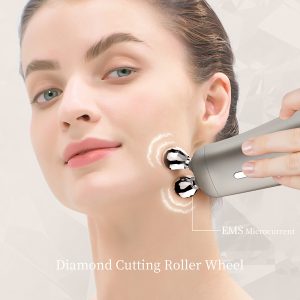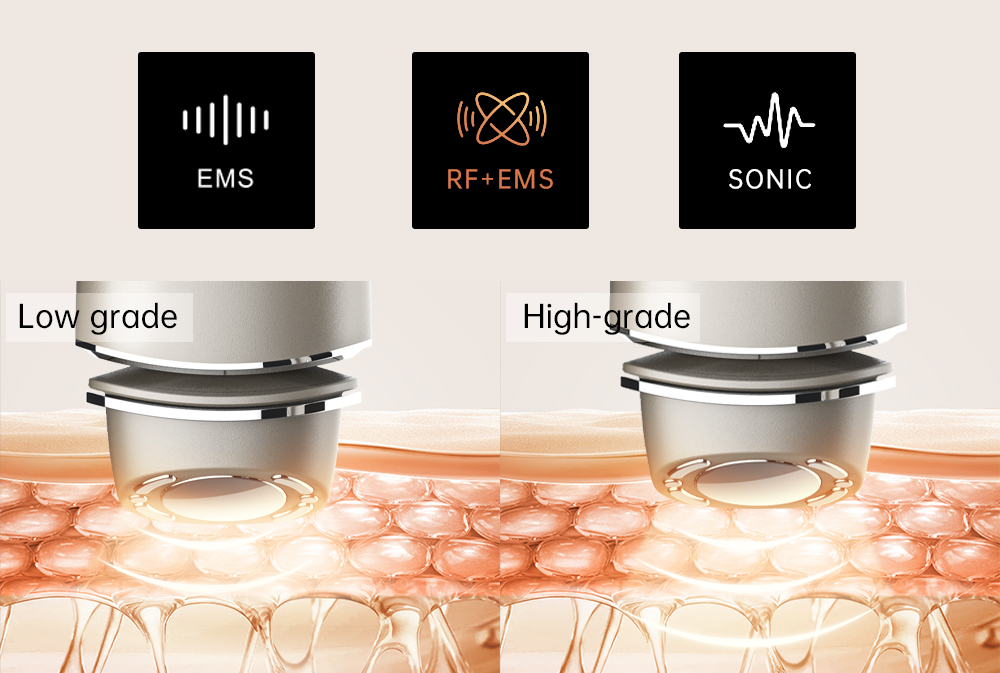RF (Radiofrequency) and HIFU (High-Intensity Focused Ultrasound) are both “lifting” treatments. They can both tighten skin and claim to have anti-aging effects, but they work in very different ways, and the experience—results, sensation, who they suit, how long they last—can vary wildly.
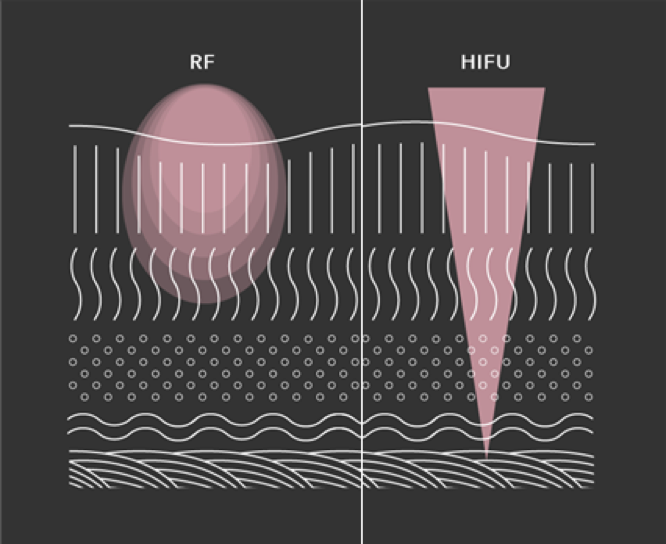
What RF and HIFU Actually Do
RF (Radiofrequency)
RF sends heat into the dermis and subdermal layers.
This heat causes:
- collagen fibers to contract immediately
- fibroblasts to start producing fresh collagen and elastin
- gradual firming and smoothing over several weeks
Think of RF like:
Warming and strengthening the supporting layers beneath your skin.
Great for:
- mild to moderate sagging
- dull or lax skin
- long-term firming

HIFU
HIFU uses focused ultrasound waves, targeting specific skin depths (including the SMAS layer—the one surgeons treat in a facelift).
It delivers:
- deeper tightening
- structural lifting
- longer-lasting change
Think of HIFU like:
Precision internal tightening at deeper levels RF doesn’t usually reach.
RF At Home – How It Works & Who It’s For
How consumer RF devices work
At-home RF devices typically heat tissues to:
~42°C–50°C
This temperature is:
- safe
- non-invasive
- high enough to trigger collagen remodeling
Typical usage:
- 2–5 sessions per week
- 10–20 minutes per session
- visible improvements in 4–12 weeks
Who RF suits best
RF is ideal for people who want:
- mild to moderate tightening
- improved tone and bounce
- softer lines
- a comfortable, routine-friendly experience
How it feels
- warm
- relaxing
- soothing
- usually zero downtime
Best treatment areas
- jawline
- cheeks
- forehead
- neck
- safe under the eye with proper technique
👉 If readers want a deeper RF comparison, link to something like RF for Face vs Body
HIFU – And Why At-Home HIFU Is Rare
How HIFU works
Professional HIFU devices use ultrasound to focus energy 3.0 mm, 4.5 mm, or deeper into the SMAS layer.
Results typically include:
- deeper tightening
- improved lower face support
- less frequent treatments
- more visibly lifted contours
But here is the realistic consumer truth:
True HIFU is rarely found in home devices.
Why?
1. Power regulations
Home devices must meet consumer electrical safety limits.
High-intensity ultrasound:
- can be painful
- can cause internal bruising
- can potentially damage nerves if used incorrectly
So most home “HIFU devices” either:
- use much lower power
- or are actually micro-ultrasound or ultrasonic vibration—not true HIFU
2. Clinical devices require expertise
Doctors and aestheticians must:
- map treatment grids
- target specific depths
- avoid areas with nerves, bone, thyroid, or thin tissues
This is not user-friendly for a beginner sitting in their bathroom mirror.
![]()
3. Cost and size
Medical HIFU devices can cost:
- USD $5,000–$50,000+
They are not designed for bedside use.
If you visit a clinic:
HIFU may deliver stronger and deeper lifting results than RF.
If you are at home:
RF is more accessible, more comfortable, and realistically more effective for the average consumer.
RF vs HIFU – Simple Comparison
| Feature | RF (Radiofrequency) | HIFU (High-Intensity Focused Ultrasound) |
|---|---|---|
| How it works | Heats dermis and subdermis | Targets deeper tissue with focused ultrasound |
| Depth | shallow to moderate | can reach SMAS |
| Sensation | warm and comfortable | can feel sharp or deep |
| Results appear | gradually (4+ weeks) | faster after clinic treatments |
| Best for | overall firming and texture | deeper sagging and structural lift |
| Frequency | 2–5× weekly at home | 1 clinic session every 3–6 months |
| At-home availability | widely available and safe | rare or low-power versions only |
| Downtime | none | possible tenderness for 48–72 hrs |

Which Helps More With…
Jawline sagging
-
Clinic HIFU delivers deeper tissue contraction
-
Home RF helps maintain tone and prevent collagen decline
Nasolabial folds
-
deeper drooping → clinical HIFU has advantage
-
long-term routine RF can gradually soften lines over time
Cheeks
-
RF improves elasticity and surface texture
-
HIFU lifts deeper structural components
Under-eye area
-
RF is safe and commonly used
-
HIFU usually avoided due to thin bone & nerve proximity
Neck
-
RF is ideal—comfortable and safe for consistent use
-
HIFU can work but usually clinic-only

Are At-Home Devices Strong Enough to Work?
Yes—if expectations are realistic.
At-home RF must stay within consumer safety limits:
-
controlled temperature
-
controlled depth
-
slower cumulative results
The upside:
-
no significant risk
-
no downtime
-
results that increase with routine use
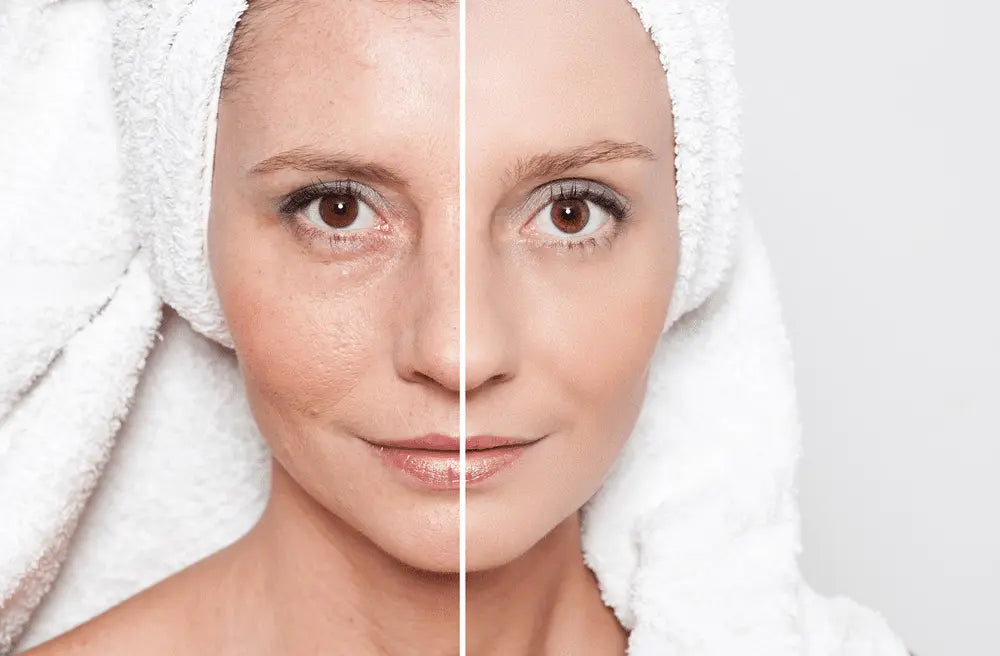
Safety Tips (RF & HIFU)
RF Safety
Don’t use RF over:
-
active cystic acne
-
recently filled areas (24–72 hr rule)
-
metal implants near the treatment zone
HIFU Safety
Avoid HIFU if:
-
you don’t have professional training
-
sensation is reduced in the area
-
you have uncontrolled thyroid issues
-
the skin is open or extremely reactive
General Best Practices
-
Use conductive gel
-
Warm heat is fine—sharp heat is not
-
More power does not equal better results
Can RF and HIFU Be Combined?
In professional clinics:
- HIFU → deeper structural tightening
- RF → ongoing collagen maintenance
A common clinical routine:
- HIFU once
- RF weekly or bi-weekly
At home, since most users only have RF:
- consistent RF can maintain the results of past clinic HIFU sessions
- and may delay the need for another appointment
Which Should You Choose?
Choose RF if you want:
-
realistic, at-home results
-
routine-based improvements
-
softer lines and better elasticity
-
something comfortable and beginner-friendly
Choose HIFU if:
-
your concerns are more structural
-
you don’t mind clinic visits
-
you want longer-lasting tissue tightening
both (path for many 30+ users):
-
HIFU in clinic every few months
-
RF at home weekly
Finally, If you are:
- a skincare brand
- a beauty influencer building a line
- a startup entering the facial device market
…and you want to develop your own at-home RF lifting device, our factory supports:
- RF and RF + EMS consumer devices
- custom industrial design (molds, color, finish)
- packaging and manual development
- app connectivity options
- safety certification support (CE, FCC, etc.)
- low-MOQ development for new brands
- full OEM & ODM services
We help create devices that:
- perform consistently
- look premium
- are safe for real consumer users
📩 Click to contact us for samples, catalogs, or RF development proposals.

